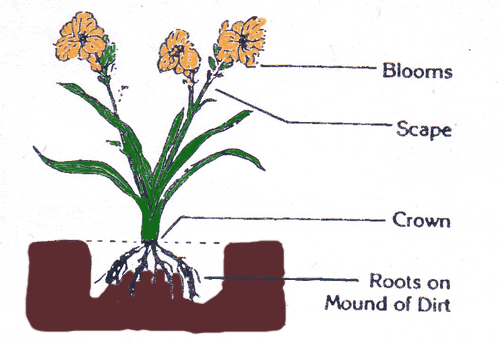|
|
|
Planting Tips
Prior to Planting Daylilies are usually sold with the soil removed from the roots (bare roots), thoroughly washed, and air dried. They may be shipped or remain out of the soil for up to five days without permanent damage if they are not exposed to too much heat or freezing conditions. The less days they are out of the soil is ideal, especially during the bloom season. Bare root plants usually have the foliage trimmed to help the plant stimulate a new and vigorous root system and new foliage. The roots of the plant should be soaked for 30 min. or up to a few hours before planting. While the plants are soaking, you could prepare the planting site. Read the fertilizer label for exact amounts, but you should take a half-strength mixture of liquid or water soluble fertilizer and dissolve in luke warm water. Daylilies have scapes, known as bloom stalks, of different heights and bloom sizes. When placing the plants in a bed, the taller scaped plants may be planted toward the back and the shorter ones in the front. They could also be placed as an accent with other flowering annuals and perennials to enhance the overall design of the bed. Daylilies should get at least a half day of sunshine. Partial shade from intense afternoon sun may help darker colored blooms to maintain their vibrant colors longer. Soil Preparation Daylilies should be planted in rich soil. The ideal environment is a flower bed or garden mixture of organic matter, topsoil and peat moss tilled to approximately one foot. Established soil can be dug and planted without soil settling, which generally occurs in newly prepared beds. Planting Daylilies At least a two foot diameter is recommended between daylilies and other annuals. This will allow plants to multiply without disturbing the root system for several years. Dig a hole that is one foot in diameter, and loosen the soil to a depth of 10-12 inches, depending on the size of the root system. A mound in the center of the hole should be firmly formed to provide support for the plant during the planting and to maintain proper depth (see illustration below). The root system should be placed around the mound, while keeping the crown of the plant, no more than one inch below finished ground level. The "crown" is that narrow area between the plant's leaves and root system. Place the remaining soil into the hole, packing gently until the root system is covered. Water with the fertilizer water used earlier to soak the plants.
Mulching Various mulches are fine for daylilies, such as pine needles, decomposed sawdust, chopped leaves, etc. However, large wood chips should be avoided, since they could attract slugs. Mulch helps retain moisture during hot or dry spells and in weed control, as well as adding to the overall beauty of the bed. Watering Water soaking is needed during the late spring and summer growth at least once per week. More frequent watering may be needed during the blooming season or very dry summers. Fertilizing Fertilization should be done in the spring, mid-summer, and fall. Use any good fertilizer (6-12-12, 8-8-8, 8-14-12, etc.). Scratch into the soil and water well. Organic fertilizers are encouraged. There are some that are available as a 'foliar' spray. Pest Control Daylilies are generally resistant to garden pests. If there is a problem, they can be easily controlled by products on the market.
|







